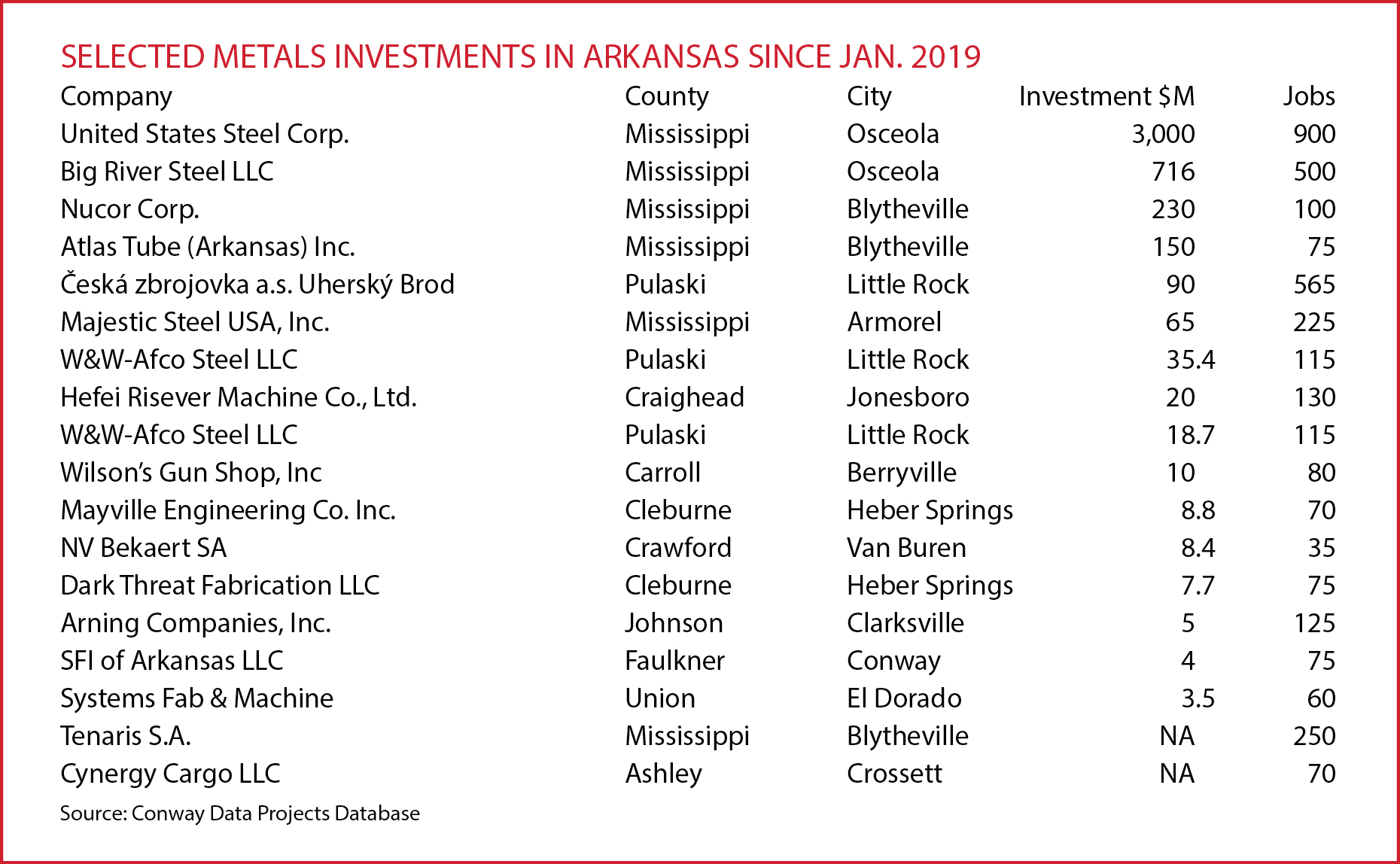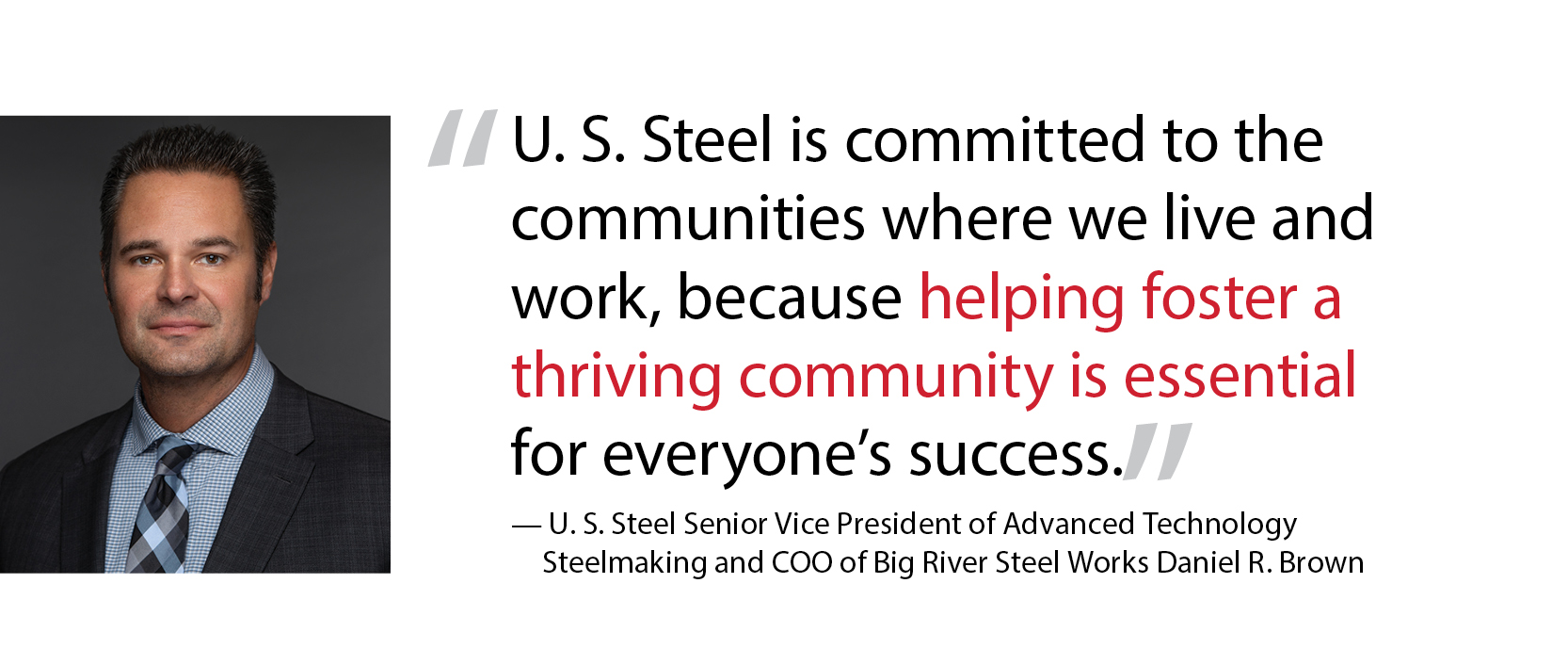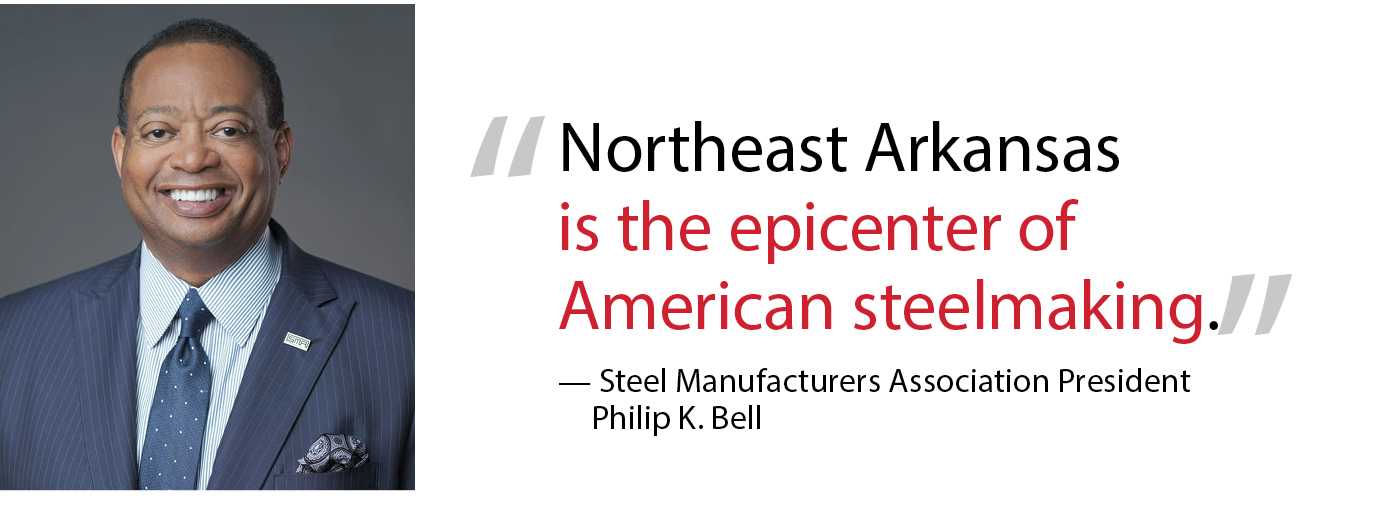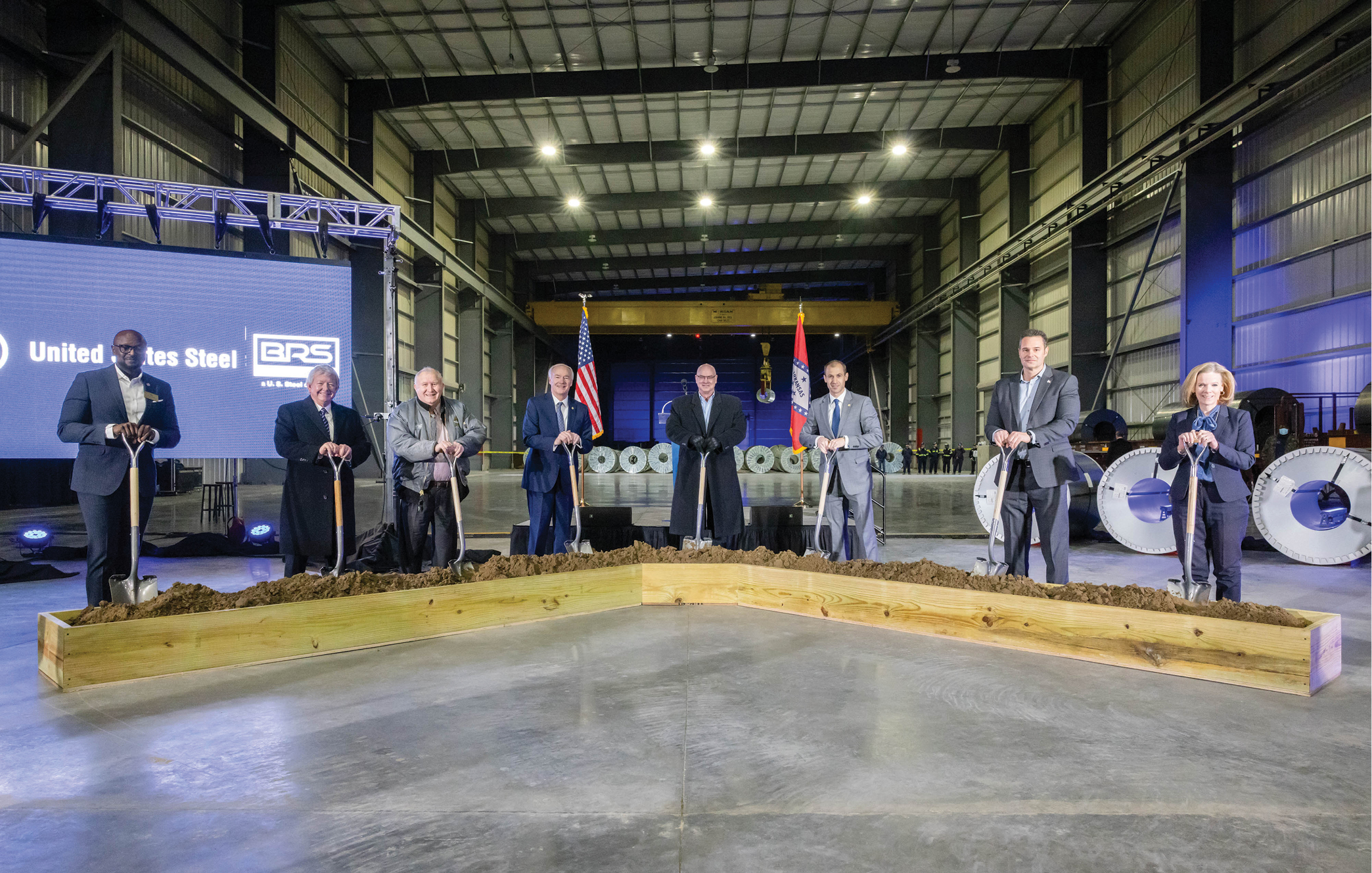Industrial diversification is an Arkansas calling card: Food processing, aerospace, machinery and logistics all possess robust profiles in the state. But underlying them all — sometimes literally — is the healthiest sector of all: metals.
Since January 2019, nearly 20% of all corporate facility investment projects in the state have occurred in the metals sector (see selected projects in chart). Those projects aren’t outliers. They include major investments from such companies as Atlas Tube and Nucor in Blytheville; Tenaris in nearby Hickman; W&W/AFCO and Ceska Zbrojovka in Little Rock; Dark Threat Fabrication and Mayville Engineering in Heber Springs; and Hefei Risever Machine Co. in Jonesboro. Chief among them is the $3 billion steel mill announced by U. S. Steel in February 2022, now under construction next door to the Big River Steel (BRS) complex the company acquired a few years ago. It’s the biggest private-sector facility investment in Arkansas history, and its operations will join with BRS to be called Big River Steel Works.

The new optimized steel production facility is expected to feature two electric arc furnaces (EAFs) with 3 million tons per year of advanced steelmaking capability, an endless casting and rolling line, and advanced finishing capabilities.
“This first use of endless casting and rolling technology in the United States brings significant energy, efficiency, and capability enhancements to the company’s operations,” said the company. It also brings 900 plant jobs to the area, along with thousands of construction jobs, as the project moves toward completion in 2024.
“With this location selected and shovel ready, we are reshaping the future of steelmaking,” said U. S. Steel President and CEO David B. Burritt. “We had numerous competitive site options, but Osceola offers our customers incomparable advantages. The State of Arkansas, Mississippi County, the City of Osceola, Entergy, BNSF and other parties have all worked to make this the clear choice for a path to the future without roadblocks. With its extraordinarily low-cost structure, energy-efficient production equipment, and advanced capabilities, this $3 billion project will yield significant benefits to our customers, stockholders, communities, employees and contribute to a more sustainable world.”
“Once this mill reaches full production, Mississippi County will be the largest steel-producing county in the nation,” said Arkansas Secretary of Commerce Mike Preston. “The company’s decision to select Osceola as the site of this mill speaks volumes about the business climate and workforce in the area. By being the home of the first mill in the country to use endless casting and rolling technology, the steel industry will continue to recognize Arkansas for its excellence in steel production.”
In September, the company donated $1 million to organizations in Osceola and Mississippi County to help equip an area medical center, police and firefighters, and other community needs. The donation sparked a companion donation of $100,000 by Entergy.
“Our acquisition of Big River Steel and investment in a new mill here is not just about delivering profitable steel solutions,” said U. S. Steel Senior Vice President of Advanced Technology Steelmaking and COO of Big River Steel Works Daniel (Dan) R. Brown. “It is also about making a positive economic impact on the greater Osceola community and helping revitalize its historic status as a bastion of American industry and innovation.”
Low-Carbon Steel to Lead Carbon-Reduction Efforts
That holistic approach is part and parcel of the company’s “Best for All” strategy that places a premium on innovation and a particular focus on sustainability in steelmaking. Arkansas is a case study in those practices too, as the Big River Steel mill in Osceola in April achieved the first-ever ResponsibleSteel™ site certification in North America. The ResponsibleSteel Standard, the industry’s only global multi-stakeholder standard and certification initiative, is based on 12 principles with a wide range of criteria covering topics such as: health and safety, greenhouse gas emissions, water stewardship and biodiversity, human rights, labor rights and community relations. “It sets a global benchmark for leading practices in environmental, social and governance (ESG) responsibility for steel production,” the company said.

“We are thrilled to be the first steel company in North America to achieve ResponsibleSteel certification for our Big River Steel site,” U. S. Steel President & CEO David B. Burritt said in April 2022. “This marks an important milestone on our journey to build a more sustainable future for our customers, company, colleagues, communities and the planet.”
ESG goals are also intrinsic to the Inflation Reduction Act passed by the U.S. Congress in August of 2022. ESG goals are also intrinsic to the Inflation Reduction Act passed by the U.S. Congress in August of 2022. U.S. Steel shared that aspects of that act might contribute to the company’s goals to continue sustainability-minded growth of its U.S. operations.
“It’s essential that we confront the threat of climate change, and the new initiatives in the Inflation Reduction Act help do that,” the company said in a statement. “U. S. Steel continues to make significant investments in clean manufacturing and applauds Congress’ efforts to do the same. We need everybody on board if we’re going to reach bold carbon emissions reduction goals, and as the Canadian and European models are showing, public-private partnerships advance decarbonization. An investment in greener domestic manufacturing also protects our national security. Tackling climate change through a strong and clean domestic manufacturing base can have a concrete impact on the safety and security of our country.
“We need all industries to be fully committed to this issue,” the statement continued. “U. S. Steel was the first USA-based steel manufacturer to publicly announce a 2050 net-zero goal and publish a climate action report outlining its overall strategy to achieve that goal. It’s a multi-faceted approach and includes everything from regional hydrogen hubs to partnerships with nonprofits and universities. We can deliver profitable steel solutions and we’re hopeful that this legislation can help the country achieve 2050 net zero goals.”

U. S. Steel is a member of the Steel Manufacturers Association (SMA), whose leaders in August similarly complimented the new legislation, which among other things creates a new office within the U.S. Department of Energy and devotes $5.8 billion to partner with industries to encourage the development and deployment of new advanced industrial technologies to reduce carbon dioxide emissions and fight climate change. Assistance will come in the form of loans, cost shares, grants and cooperative agreements used to pay 50% of the cost of “new technology that is directly involved in an industrial process and designed to accelerate greenhouse gas reductions to net-zero at an eligible facility.”
“The true impact of this bill will have to be measured over time, as it will impact individuals, companies, and industries in different ways,” said SMA President Philip K. Bell. “But we know this for sure, America’s Electric Arc Furnace steelmakers, who today produce the highest quality steel with the lowest emissions found anywhere in the world, look forward to partnering with the Department of Energy’s new Office of Clean Energy Demonstrations to further decrease our already historically low emission rates. By working together, we will not only supercharge the fight against climate change today, but we will create a new model for low carbon steel that will lead the global steel industry into the future.”
According to Bell, Arkansas is attracting much investment from his industry.
“Northeast Arkansas is the epicenter of American steelmaking,” he says. “It is the No. 1 region in the U.S. in terms of making sustainable low-carbon steel. An eager workforce, progressive state incentives and proximity to barge, rail and trucking transport make this region well suited for domestic steelmaking. Plus, the area is within 500 miles of most major customers.”
Making sure the region stays No. 1 means making sure it maintains a reliable and fortified electric grid, he says. “It must also support an education system that prepares 21st century steelmakers. STEM education is at the core of this.”
How seriously is the steel industry taking its ESG commitments? Again, Northeast Arkansas offers the best evidence.
“One should look no further than the low carbon intensity of the steel produced,” Bell says. “According to a recent Steel Manufacturers Association study, steel produced in the region is up to 75% lower in carbon intensity than steel produced globally. That number will only get better due to expansion and growth of companies like Big River Steel and the continued growth of EAF steelmaking, which now accounts for over 70% of the steel made in the U.S.”
The Natural State, it appears, could be a case study for a healthier planet, a healthy steel sector and a robust area economy all at once.

